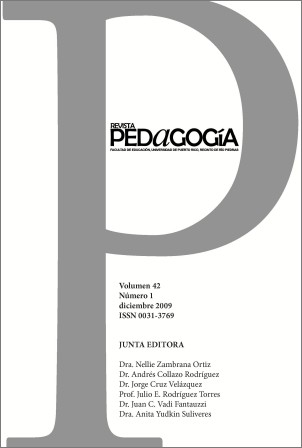Abstract
This exploratory study examined the validity of the results obtained from the administration of the Beery VMI to a sample of Puerto Rican children. The process included translation of test instructions, interviews with four professionals that use the test in their clinical practice, and the administration of the test to 50 Kindergarten students from two schools in San Juan, Puerto Rico. Quantitative and qualitative data was collected as established by the Standards for Educational and Psychological Testing (1999): test content, response process, internal structure, relation to other variables, and test consequences. Information regarding test content, response process, and test consequences supported the validity of the results. However, more research is needed to reach a definitive conclusion.
How to cite:
Román-Oyola, R., & Bonilla-Rodríguez, V. E. (2011). Beery-Buktenica Visual Motor Integration Test: Validity evidence examination. Pedagogía, 42(1), 193-222. Retrieved from https://revistas.upr.edu/index.php/educacion/article/view/16671
References
Allen, M., & Yen, W. (2002). Introduction to measurement theory (2nd ed.). Long Grove, IL: Waveland Press. American Educational Research Association, American Psychological
Association, & National Council of Measurement in Education. (1999). Standards for educational and psychological testing. Washington, DC: American Psychological Association.
Beery, K., & Beery, N. (2004). The Beery-Buktenica Developmental Test of Visual-Motor Integration: Administration, scoring and teaching manual (5thed.). Minneapolis, MN: NCS Pearson.
Bonilla-Landrón, M. (2002). La lectoescritura en preescolares con y sin rezago en el desarrollo y el aprendizaje: Discursos y prácticas de dos maestras de Kindergarten. Unpublished master‘s thesis, Universidad de Puerto Rico, Río Piedras, Puerto Rico.
Braverman, M. T., & Slater, J. K. (1996). Advances in survey research: New directions for evaluation. San Francisco, CA: Jossey-Bass.
Case-Smith, J. (2002). Effectiveness of school-based occupational therapy intervention on handwriting. American Journal of Occupational Therapy, 56 (1), 17-25.
Christiansen, C., & Lou, J. (2001). Ethical considerations related to evidencebased practice. American Journal of Occupational Therapy, 55 (3), 354-349.
Creswell, J. (2005). Educational research: Planning, conducting and evaluating quantitative and qualitative research (2nd ed.). Upper Saddle River, NJ: Merill-Prentice Hall.
Cornhill, H., & Case-Smith, J. (1996). Factors that relate to good and poor handwriting. American Journal of Occupational Therapy, 50(9), 732-739.
Cohen, J. (1988). Statistical power analysis for the behavioral sciences (2nded.). Hillsdale, NJ: Lawrence Erlbaum Associates.
Crano, W., & Brewer, M. (1973). Principles of research in social psychology. New York: McGraw-Hill.
Daly, C., Kelley, T., & Krauss, A. (2003). Relationship between visual motor integration and handwriting skills of children in Kindergarten: A modified replication study. American Journal of Occupational Therapy, 57(4), 459-462.
Fowler, F. J. (2002). Survey research methods (3rd ed.). Thousand Oaks, CA: Sage Publications.
Frey, P., & Pinelli, B. Jr. (1991). Visual discrimination and visuomotor integration among two classes of Brazilian children. Perceptual and motor skills, 72, 847-850.
Gorsuch, R. (1983). Factor analysis (2nd ed.). Hillsdale, NJ: Lawrence Erlbaum Associates.
Grissom, R. J., & Kim, J. J. (2005). Effect sizes for research: A broad practical approach. Mahwah, NJ: Lawrence Erlbaum Associates.
Hinkle, D., Wiersma, W., & Jurs, S. (2003). Applied statistics for the behavioral sciences (5th ed.). Boston, MA: Houghton Mifflin Company.
Hsu, H. (1997). Performance of primary school children in Taiwan on the Beery Developmental Test of Visual-Motor Integration (China). Unpublished master‘s thesis, University of Southern California, California, United States.
Institute of Phonetic Sciences, Amsterdam. (1996). Two correlation coefficients [Web service]. Retrieved August 29, 2006 from http://www.fon.hum.uva.nl/Service/Statistics/Two_Correlations.html
Kulp, M., & Sortor, J. (2003). Clinical value of the Beery Visual-Motor Integration Supplemental Tests of visual perception and motor coordination. Optometry and Vision Science, 80(4), 312-315.
Marr, D., Windsor, M., & Cermak, S. (2001). Handwriting readiness: Locatives and visualmotor skills in the Kindergarten year. Utica, NY: Early Childhood Research & Practice: An Internet Journal on the Development, Care and Education of Young Children. (ERIC Document Reproduction Service No. ED452998)
Marriott, G. (2000). Developmental differences in visual-motor integration in children from 4 to 6- years-old on the Kindergarten Diagnostic InstrumentSecond edition. Unpublished doctoral dissertation, Texas Woman‘s University, Texas, United States.
McHale, K., & Cermark, S. (1992). Fine motor activities in elementary school: Preliminary findings and provisional implications for children with fine motor problems. American Journal of Occupational Therapy, 46(10), 898- 903.
McMillan, J. (2004). Educational research: Fundamentals for the consumer (4th ed.). Boston, MA: Pearson Education.
Messick, S. (1989). Meaning and values in test validation: The sciences and ethics of assessment. Educational Researcher, 18(2), 5-11.
Portney, L., & Watkins, M. (2000). Foundations of clinical research: Applications to practice (2nd ed.). Upper Saddle River, NJ: Prentice Hall Health.
Richardson, P. (2001). Use of standardized test in pediatric practice. In J. Case-Smith (Ed.), Occupational therapy for children (pp. 217-245). Saint Louis, MO: Elsevier Science.
Stevens, J. (2001). Applied multivariate statistics for the social sciences (4ht ed.). Hillsdale, NJ: Lawrence Erlbaum Associates.
Tabachnick, B., & Fidell, L. (2007). Using multivariate statistics (5th ed.). Boston, MA: Pearson Allyn & Bacon.
Tseng, M., & Murray, E. (1994). Differences in perceptual-motor measures in children with good and poor handwriting. Occupational Therapy Journal of Research, 14 (1), 19-36.
Verdonck, M. C., & Henneberg, M. (1997). Manual dexterity of South African children growing in contrasting socioeconomic conditions. American Journal of Occupational Therapy, 51, 303-306.
Weintraub, N., & Graham, S. (2000). The contribution of gender, orthographic, finger function, and visual-motor processes to the prediction on handwriting status. Occupational Therapy Journal of Research, 20(2), 321-34.

This work is licensed under a Creative Commons Attribution-NonCommercial 4.0 International License.

